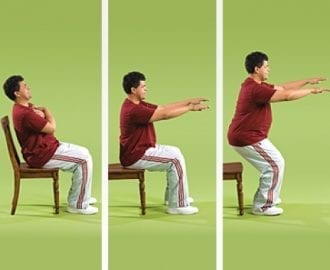Strong knees, not belly fat, predict better function after menopause
If you’re getting around just fine, thank you, it may be because of your strong legs. Sounds logical, right? Not to the menopause research community.
There has been a lot of buzz among researchers about abdominal fat, a.k.a. “belly fat” and its affect on our ability to function over age 50 (50? really?). “Function,” in this case, is defined as our ability to go about daily life — walk, dress, get outside, shop, work, garden — normal stuff. Previous studies showed that there was a correlation between that jiggly tummy we seem to develop after menopause and our ability to maintain normal function.
But a new study, just published in the journal Menopause, refutes that theory for women who are already active. Although there is evidence that abdominal fat (and a larger waist measurement) can interfere with daily life among sedentary women, for active post menopausal women, strong legs – especially knees – are important to maintain function.
The study was conducted with 44 women from ages 50-70 at the University of Quebec in Montreal. The women all had a BMI (body mass index) that was normal or slightly overweight and met criteria as non-smokers, no history of heart disease or diabetes and moderate alcohol consumption (2 drinks or less per day). The women were put through a battery of tests to gauge their physical functionality.
What did they measure?
The tests included:
1) Chair stand test – rising from a chair with arms crossed over the chest as many times as possible within 20 seconds
2) The one leg test – standing on one leg as long as possible up to 60 seconds
3) The step touch test – alternately foot toe touching an 8″ step (20 cm) as quickly as possible
There were other tests that measured heart, lungs, hand grip strength and knee extensor strength. The bottom line was that a thicker waistline or extra fat in the tummy area was NOT associated with lower function among active women. The important factor was lower leg strength, in particular knee strength.
So get out there and work those knees! Some simple ways to get started at home:
- Knee extensions
Sit in a chair with your feet flat on the floor. Extend one leg so it is parallel to the floor, flex your foot for a moment, then return to original position;repeat with other foot. Use a towel under your legs if it helps. As you build strength, use 2 to 5 pound ankle weights to strengthen your knees even more.
- Chair stand
Make the chair stand test (above) part of your day. Get up from a chair without using your hands. Try to maintain an upright posture instead of leaning forward to lift yourself – lift from your knees. Whew – tough at first, but it gets easier.
- Wall slide
Lean your back flat against the wall and assume a “sitting” position. Gradually slide your back down the wall. Hold for 20 seconds (or as long as you can). Thenslide back up maintaining your posture. Works even better when you put a medium sized rubber or plastic ball between your knees as you slide and extend your arms in front of you.

- Stairs!
Walk up and down stairs instead of taking the elevator!

As always, do these exercises based on your own physical ability and/or limitations. Women tend to have more trouble with knees than men as we grow older, so keep them flexible and moving as much as possible!
Source: Functional capacity depends on lower limb muscle strength rather than on abdominal obesity in active postmenopausal women.
Dulac, Maude C. PhD; Carvalho, Livia Pinheiro PhD; Aubertin-Leheudre, Mylène PhD, Menopause, August 21, 2017






This is my first time pay a visit at here and i am really impressed to read everthing at single
place.
What’s Taking place i’m new to this, I stumbled upon this I have found It positively useful
and it has helped me out loads. I’m hoping to give a contribution & assist
different customers like its helped me. Good job.
I got this web site from my buddy who informed me concerning this site and at the moment this time I am
visiting this web site and reading very informative content here.